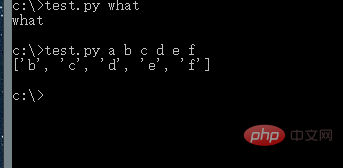What is sys in python
 sys.argv[] To put it bluntly, it is a bridge to obtain parameters from outside the program. This "external" is very critical, so those who try to explain its function from the code have never understood it.
sys.argv[] To put it bluntly, it is a bridge to obtain parameters from outside the program. This "external" is very critical, so those who try to explain its function from the code have never understood it.
Because we can get multiple parameters from the outside, what we get is a list. That is to say, sys.argv can actually be regarded as a list, so we can use [] to extract the parameters. element. The first element is the program itself, followed by externally given parameters.
Below we illustrate its usage through the running results of a very simple test.py program.

Save test.py in the root directory of the c drive.
Find 'Run' in the program->Click->Enter "cmd"->Enter key to enter the console command window (as shown below), first enter cd c:\ (the function is to Change the command path to the root directory of drive c), then enter test.py to run the program we just wrote:

The result is C:\test.py, which is 0 refers to the code (that is, this .py program) itself.
Then we change the 0 in the code to 1:
a=sys.argv[1]
After saving, run it from the console window. This time we add a parameter and enter: test.py what

The result obtained is what we entered as the parameter. Do you begin to understand when you see this?
Then let’s modify the code again:
a=sys.argv[2:]
After saving, run the program from the console window. This time add a few more parameters, separated by spaces:
test.py a b c d e f

The result obtained is ['b', 'c', 'd', 'e', 'f']
You should be enlightened now. Sys.argv[ ] is actually a list, and the items inside are parameters input by the user. The key is to understand that these parameters are input from outside the program, rather than somewhere in the code itself. If you want to see its effect, you should The program is saved, and the program can be run externally and given parameters.
Related learning recommendations: python tutorial
The above is the detailed content of What is sys in python. For more information, please follow other related articles on the PHP Chinese website!

Hot AI Tools

Undresser.AI Undress
AI-powered app for creating realistic nude photos

AI Clothes Remover
Online AI tool for removing clothes from photos.

Undress AI Tool
Undress images for free

Clothoff.io
AI clothes remover

AI Hentai Generator
Generate AI Hentai for free.

Hot Article

Hot Tools

Notepad++7.3.1
Easy-to-use and free code editor

SublimeText3 Chinese version
Chinese version, very easy to use

Zend Studio 13.0.1
Powerful PHP integrated development environment

Dreamweaver CS6
Visual web development tools

SublimeText3 Mac version
God-level code editing software (SublimeText3)

Hot Topics
 1377
1377
 52
52
 How to solve the permissions problem encountered when viewing Python version in Linux terminal?
Apr 01, 2025 pm 05:09 PM
How to solve the permissions problem encountered when viewing Python version in Linux terminal?
Apr 01, 2025 pm 05:09 PM
Solution to permission issues when viewing Python version in Linux terminal When you try to view Python version in Linux terminal, enter python...
 How to efficiently copy the entire column of one DataFrame into another DataFrame with different structures in Python?
Apr 01, 2025 pm 11:15 PM
How to efficiently copy the entire column of one DataFrame into another DataFrame with different structures in Python?
Apr 01, 2025 pm 11:15 PM
When using Python's pandas library, how to copy whole columns between two DataFrames with different structures is a common problem. Suppose we have two Dats...
 How to dynamically create an object through a string and call its methods in Python?
Apr 01, 2025 pm 11:18 PM
How to dynamically create an object through a string and call its methods in Python?
Apr 01, 2025 pm 11:18 PM
In Python, how to dynamically create an object through a string and call its methods? This is a common programming requirement, especially if it needs to be configured or run...
 How to teach computer novice programming basics in project and problem-driven methods within 10 hours?
Apr 02, 2025 am 07:18 AM
How to teach computer novice programming basics in project and problem-driven methods within 10 hours?
Apr 02, 2025 am 07:18 AM
How to teach computer novice programming basics within 10 hours? If you only have 10 hours to teach computer novice some programming knowledge, what would you choose to teach...
 How does Uvicorn continuously listen for HTTP requests without serving_forever()?
Apr 01, 2025 pm 10:51 PM
How does Uvicorn continuously listen for HTTP requests without serving_forever()?
Apr 01, 2025 pm 10:51 PM
How does Uvicorn continuously listen for HTTP requests? Uvicorn is a lightweight web server based on ASGI. One of its core functions is to listen for HTTP requests and proceed...
 What are some popular Python libraries and their uses?
Mar 21, 2025 pm 06:46 PM
What are some popular Python libraries and their uses?
Mar 21, 2025 pm 06:46 PM
The article discusses popular Python libraries like NumPy, Pandas, Matplotlib, Scikit-learn, TensorFlow, Django, Flask, and Requests, detailing their uses in scientific computing, data analysis, visualization, machine learning, web development, and H
 How to handle comma-separated list query parameters in FastAPI?
Apr 02, 2025 am 06:51 AM
How to handle comma-separated list query parameters in FastAPI?
Apr 02, 2025 am 06:51 AM
Fastapi ...
 How to avoid being detected by the browser when using Fiddler Everywhere for man-in-the-middle reading?
Apr 02, 2025 am 07:15 AM
How to avoid being detected by the browser when using Fiddler Everywhere for man-in-the-middle reading?
Apr 02, 2025 am 07:15 AM
How to avoid being detected when using FiddlerEverywhere for man-in-the-middle readings When you use FiddlerEverywhere...




